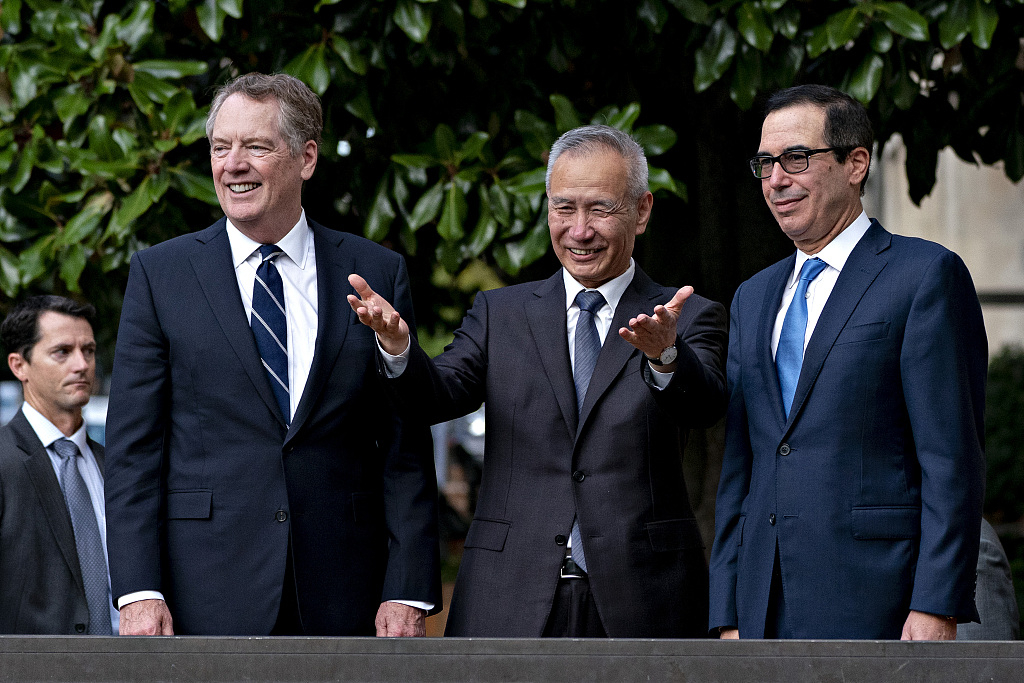Editor's Note: The following is an edited translation of a commentary that was first published in the Chinese-language "Commentaries on International Affairs."
Top trade officials from China and the United States had a telephone conversation on October 25. The two sides agreed to address each other's core concerns and confirmed that the technical consultations regarding part of the text for a preliminary trade agreement was essentially completed.
A concrete implementation of the outcomes of the latest round of China-U.S. high-level trade talks two weeks ago, this shows that the two sides have taken a step further towards the signing of an interim trade agreement as a response to market expectations.
Substantial headway was made in multiple areas as a result of the latest round of high-level trade talks two weeks ago, paving the way for a phased agreement. Trade representatives on both sides have since maintained close contact and held frequent consultations in accordance with agreement reached during the talks. The message sent by the call on October 25 signals that the intensive and concerted effort made by the two countries' trade officials has yielded positive results.
For China and the U.S to reach a trade agreement, the key is to accommodate each other's core concerns on the basis of equality and mutual respect. China is taking concrete actions to address the U.S.' major concerns in areas such as the purchase of U.S. agricultural goods and the regulation of fentanyl exports. In the meantime, China's core concerns are threefold – namely the removal of all tariffs imposed in the trade war, a realistic volume of U.S. goods purchases that China will make, and a "balanced" text for the trade deal.
The agreement reached during the call to properly address each other's core concerns signifies that the two sides will be making concerted efforts to remove the greatest obstacles to achieving their common goals. This is undoubtedly conducive to enhancing mutual trust and facilitating negotiations.

Chinese Vice Premier Liu He (C) gestures towards members of the media while arriving for a meeting with Steven Mnuchin, U.S. treasury secretary (R), and Robert Lighthizer, U.S. trade representative, at the Office of the U.S. Trade Representative in Washington, D.C., U.S., October 10, 2019. /VCG Photo
Chinese Vice Premier Liu He (C) gestures towards members of the media while arriving for a meeting with Steven Mnuchin, U.S. treasury secretary (R), and Robert Lighthizer, U.S. trade representative, at the Office of the U.S. Trade Representative in Washington, D.C., U.S., October 10, 2019. /VCG Photo
The phone talks have also confirmed that the technical consultations regarding part of the text for a preliminary trade deal are essentially completed, and that agreement has been made that the United States will import Chinese-made cooked poultry and catfish products, while China will lift a ban on U.S. poultry. This is a very important development. It shows that the two sides are solving some technical problems, advancing towards a common goal and further laying the foundation for signing a phased agreement.
During this call, top trade officials of both sides also confirmed that they will call again in the near future, and that during this period, the two countries' trade officials will keep up discussions. This has set a clear direction for the next stage of work. It can be expected that trade representatives of both sides will step up their efforts to facilitate the signing of an interim agreement.
After more than a year of talks and disputes, it is not easy for China and the U.S. to get back on track. At present, the China-U.S. trade talks have entered a critical stage. Both sides should seize the hard-won opportunity, give priority to the interests of producers and consumers, seek common ground while reserving differences, keep moving towards the common goal, strive to create a good environment, stress cooperation over disputes, and make unremitting efforts towards the goal of reaching an agreement.
As long as China and the U.S. manage differences on the basis of mutual respect and expand cooperation on the basis of mutual benefit, it is possible for the two countries to reach a trade agreement that is beneficial to both sides and the world as a whole.
(If you want to contribute and have specific expertise, please contact us at opinions@cgtn.com.)